Apr 08, 2023
History and Human Biology Argue for Warmth, not Cold
By Vijay Jayaraj
To those who have been misled to believe that a warming planet is dangerous, prepare to have a myth shattered: Data from hundreds of scientific journals across major publishing platforms and policy reports from major governments say cold is responsible for more deaths than hot weather worldwide.
Nonetheless, many people find it hard to believe this fact because of the decades-long propaganda and hysteria surrounding global warming. Here is why we should be thankful that our world is warming.
Human Body is Made for Warm Weather
Humans evolved in warm environments. The body is better equipped to handle heat than cold as it can regulate temperature through sweating and other mechanisms. However, in cold weather, our bodies must work harder to maintain a normal temperature, which can lead to a variety of health problems.
Anecdotes of heart attacks induced by shoveling snow are common in northern climes. When exposed to cold temperatures, the body’s blood vessels constrict to conserve heat, which can increase blood pressure and strain the heart.
The relative dryness of cold air is irritating to airways, causing inflammation and making breathing more difficult, particularly for those with preexisting respiratory conditions like asthma or chronic obstructive pulmonary disease (COPD).
So, it is no wonder that civilizations flourished when temperatures were higher, especially when home heating was primitive or nonexistent.
Lessons from Norse Farming in Greenland
Some of the earliest civilizations - such as those in Mesopotamia, Egypt, and the Indus Valley - developed in warm, arid regions with fertile soils and abundant water resources. They were able to support large populations that developed sophisticated technologies, such as irrigation systems that made agriculture possible in dry lands.
Warmer temperatures are associated with higher crop yields, particularly for plants like wheat, rice and maize. Greater warmth increases the length of the growing season and improves the rate of photosynthesis.
In contrast, colder regions like northern Europe and Asia were historically less hospitable to human populations. In these regions, food production was more difficult and the risk of famine and disease higher. The only time life in colder regions was favorable is when there were centuries-long warming phases.
An example of this is the Vikings who developed a thriving civilization in Scandinavia and grew food in Greenland during the Medieval Warm Period. Charred grains and waste from threshing grain proved that barley was cultivated in Greenland by medieval Norse farmers.
As summer and winter temperatures decreased with the waning of medieval warmth, Vikings abandoned farming and turned to seafood. “Greenland’s climate worsened during the Norse colonization,” says Eli Kintisch in “Science” magazine. “In response, the Norse turned from their struggling farms to the sea for food before finally abandoning their settlements.”
Kintisch continues, “It was a sustainable lifestyle for hundreds of years. But in the 13th century, economics and climate began to conspire against the Norse. After 1250, a cooling climate posed multiple threats to a marine-oriented society.”
Even in moderate parts of Europe, the 16th century Little Ice Age was horrific. “All things which grew above the ground died and starved,” reported the National Post.
“The cold was so extreme and the freeze so great and bitter, that nothing seemed like it in the memory of man,” recalls Pierre de l’Estoile, the diarist.
Then, a warming that began in the 17th century and continues to the present day restored more bountiful harvests and a measure of food security that allowed time and energy for innovation and the onset of the Industrial Revolution. Since then, the human population has increased 10-fold.
So, the notion that warming is killing the planet is false. In fact, it is dangerous to direct public policy toward reducing the global temperature.
This commentary was first published at BizPac Review, April 6, 2023..
Vijay Jayaraj is a Research Associate at the CO2 Coalition, Arlington, Virginia. He holds a master’s degree in environmental sciences from the University of East Anglia, UK and resides in India.
Apr 01, 2023
Southwestern states setting snow records in a brutal throwback winter!
Joseph D’Aleo, CCM
Mammoth Mountain ski area in California exceeded all-time snowfall record this past week. Mammoth Mountain surpassed its all-time record of snowfall this season with 702 inches recorded at the main lodge on Wednesday.
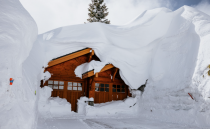
Enlarged
The resort says historical snowfall records are kept at the Main Lodge. The previous record was in the 2010/2011 La Nina season which had a total of 668 inches.
The mountain’s peak, which is at an elevation of 11,053 feet, received over 870 inches of snow this season, leaving a base depth of 336 inches as of Wednesday, March 29.
Unlike 2021/22 which had 1 big month, 2022/23 had 5 signifiant snow months, with 220 in January and 192 inches in March.
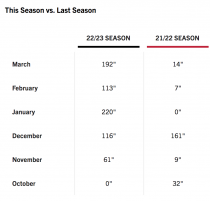
Enlarged

Enlarged
They expect ski lifts will be open to July.
Oh and the water level at Lake Oroville is 856.97 feet (95% of the max level 900 feet).

Enlarged
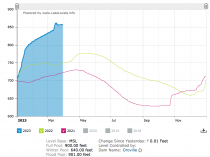
Enlarged
BTW KSL AND FOX 13 In Salt Lake City report Utah has set a state record for snowfall with well over 800 inches in Alta. Alta Ski Area has received more than 2.5 feet of snow since Thursday morning, pushing its seasonal total to over 800 inches early Friday morning. As of noon, 809 inches of snow, or more than 67 feet, of snow have fallen in the area since October. The resort’s previous record - since at least 1980 - was 748 inches, which was broken last week.
“This endless winter continues to produce staggering snow totals,” resort officials wrote on social media and on its website. “Alta has received some of the highest snowfall totals on the planet.”
Mar 17, 2023
California’s wild winter
By Joseph D’Aleo
The main lodge at Mammoth Mountain in California has reached 618 inches (more than 50 feet) for the season. The record was 668 inches in 2010/11. At the summit, the seasonal total is at 784 inches (over 65 feet)
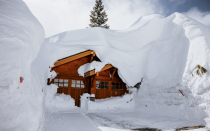
Enlarged

Enlarged
The last time the resort had this much snow was during the 2016/2017 season, making this the second snowiest season for Mammoth Mountain in the last 10 years.
The all-time record for the most snow at Mammoth Mountain was in the 2010/11 Season with 668 inches. The mountain does expect to break that record in the coming weeks.
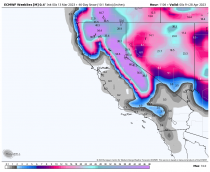
Enlarged
Meanwhile water levels in the reservoirs are rising fast.
Winter storms across California have significantly improved drought conditions and filled state reservoirs that had held less than a third of their capacity.
Drone photos from the California Department of Water Resources show just how big a difference a recent series of storms, brought on by 11 major winter storms has made.
The image below shows Lake Oroville in Butte County, California’s second-biggest reservoir. The first image was taken Dec. 21. The second image was taken Jan. 12, after several storms had begun to refill the reservoir. The last image was taken March 8 and shows a dramatic improvement in the water level.
In the first image, the lake was at just 29% of its capacity. In the second image, the level had jumped to 51%. And by the third photo, the figure was up to 75%.
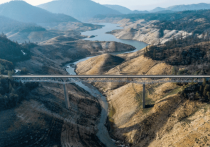
Enlarged
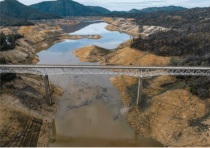
Enlarged
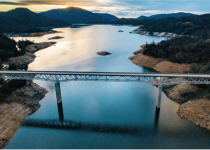
Enlarged
As of Tuesday, Folsom Lake was at 63% of its capacity, in line with the historical average level.
The winter storms have eased drought conditions across the state and prompted authorities to lift mandatory water restrictions for millions of Southern California residents.
This story originally appeared in Los Angeles Times.
Precipitation total forecasts to May 1:
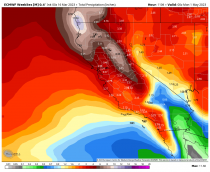
Enlarged
The trend since 1890 for winter precipitation is just -0.01 inch per decade with ups and downs.

Enlarged
Feb 21, 2023
Green Energy - The Greatest Wealth Transfer to the Rich in History!
By Steve Goreham
Originally published in Master Resource.

We are in the midst of history’s greatest wealth transfer. Government subsidized support for wind systems, solar arrays, and electric vehicles overwhelmingly benefits the wealthy members of society and rich nations. The poor and middle class pay for green energy programs with higher taxes and higher electricity and energy costs. Developing nations suffer environmental damage to deliver mined materials needed for renewables in rich nations.
Since 2000, the world has spent more than $5 trillion on green energy. More than 300,000 wind turbines have been erected, millions of solar arrays were installed, more than 25 million electric vehicles (EVs) have been sold, hundreds of thousands of acres of forest were cut down to produce biomass fuel, and about three percent of agricultural land is now used to produce biofuel for vehicles. The world spends about $1 trillion per year on green energy. Government subsidies run about $200 billion annually, with more than $1 trillion in subsidies spent over the last 20 years.
World leaders obsess over the need for a renewable energy transition to save the planet from human-caused global warming. Governments deliver an endless river of cash to promote adoption of green energy. The Inflation Reduction Act of 2022 provided $370 billion in subsidies and loans for renewables and EVs. But renewable subsidies and mandates overwhelmingly favor the rich members of society at the expense of the poor.
Wind systems receive production tax credits, property tax exemptions, and sometimes receive payments even when not generating electricity. Landowners receive as much as $8,000 per turbine each year from leases for wind systems on their land. Lease income can be quite high for a landowner with many turbines. In England, ordinary taxpayers pay hundreds of millions of pounds per year in taxes that are funneled as subsidies to wind companies and wealthy land owners.
In the US, 39 states currently have net metering laws. Net metering provides a credit for electricity generated by rooftop solar systems that is fed back into the grid. Solar generators typically get credits at the retail electricity rate, about 14 cents per kilowatt-hour. This is a subsidized rate, which is more than double the roughly five cents per kilowatt-hour earned by power plants. Apartment residents and homeowners that cannot afford to install rooftop solar pay higher electricity bills to subsidize homes that receive net metering credits. Rooftop solar owners also receive federal and state tax incentives, another wealth transfer from ordinary citizens.
US federal subsidies of up to $7,500 for each electric car purchased, along additional state subsidies, directly benefit EV buyers. The average price of an EV in the US last year was $66,000, which is out of reach for most drivers. A 2021 University of Chicago study found that California EV owners only drive 5,300 miles per year, less than half the mileage for a typical car. Most electric cars in the US are second cars for the rich.
A mid-size electric car needs a battery that weighs about a 1,000 pounds to provide acceptable driving range. Because of battery weight, EVs tend to be about 50 percent heavier than gasoline cars, which causes increased road damage. But EVs don’t pay the road tax included in the price of every gallon of gasoline. EVs should pay higher road taxes than traditional cars, but today this cost is borne by everyday gasoline car drivers.
Renewable systems require huge amounts of special metals. Electric car batteries need cobalt, nickel, and lithium to achieve high energy density and performance. Magnets in wind turbines require rare earth metals, such as neodymium and dysprosium. Large quantities of copper are essential for EV engines, batteries, wind and solar arrays, and electricity transmission systems to connect to remote wind and solar sites. According to the International Energy Agency, an EV requires about six times the special metals of a gasoline or diesel car. A wind array requires more than ten times the metals of a natural gas power plant on a delivered-electricity basis. The majority of these metals are mined in developing countries.
Almost 70 percent of cobalt is mined in the Democratic Republic of the Congo. Indonesia produces more than 30 percent of the world’s nickel. Chile produces 28 percent of the copper. China produces 60 percent of the rare earth metals. These nations struggle with serious air and water pollution from mining operations. Workers in mines also suffer from poor working conditions and the use of forced labor and child labor practices. But apparently no cost is too great so that rich people in developed nations can drive a Tesla.
To top it off, the European Union recently approved a Carbon Border Adjustment Mechanism (CBAM). The CBAM will tax goods coming from poor nations which aren’t manufactured using low-carbon processes. CBAM revenues will be a great source of funds for Europe’s green energy programs that benefit the wealthy.
In January, California, Connecticut, Hawaii, Illinois, Maryland, New York, and Washington proposed a wealth tax on billionaires. It’s interesting to note that all seven of these states mandate and heavily subsidize wind and solar arrays and electric vehicles, which transfer wealth from poor and middle-class residents to those same billionaires.
Steve Goreham is a speaker on energy, the environment, and public policy and author of the book Outside the Green Box: Rethinking Sustainable Development.
Feb 16, 2023
Greenpeace Betrays Founders to Peddle Junk Science
Dr. Patrick Moore
Since 2016, when acoustic sonar surveys required for construction of 1,500 wind turbines began on the U.S. Atlantic coast, 174 Humpback whales have washed ashore dead. This represents a 400 percent increase in mortalities from previous years. And then there are the highly endangered North Atlantic right whales, of which less than 400 individuals exist today. They recovered somewhat after being hunted to near extinction in the 1930’s, but now they are thought to be declining.
Federal government agencies such as the National Oceanic and Atmospheric Administration (NOAA) are authorizing the sonar surveys. Greenpeace, the organization I helped found in 1971, has sided with the wind turbines over the whales, stating there is no “proof” that sonar is involved in this tragedy. Here is a quote from a Greenpeace spokesperson:
“At this time, due to the lack of evidence suggesting harm from offshore wind development, Greenpeace’s position remains that the best way to protect whales is to create ocean sanctuaries, eliminate single-use plastics at the source, and stop our dependency on oil and gas.”
Perhaps it would be a good idea to put the “ocean sanctuaries” where the whales live.
It is a fact that mortalities among whales in this region are often caused by entanglement in fishnets and by vessel strikes. But a 400 percent increase in whale deaths, coincident with the sonar program, should cause environmentalists like Greenpeace to swing into action and spend some of their hundreds of millions on a thorough research program. Instead, they are doing nothing. Well, they do cruise around in their $30 million yacht which they call a “sailing vessel” even though there is an 1,850-horsepower diesel engine in the hold which provides the main propulsion.
It is understandable that federal agencies like NOAA would downplay the concern for the whales. The Biden administration is dead set on building all these contraptions even though they will be much more expensive and far less reliable than nuclear, hydroelectric, or fossil fuel generators.
Whales are acoustic species that use sonar to see the world around them. They have eyes for close-up recognition, but their sonar is how they navigate and speak to each other.
It is not only the sonar surveys that may pose a real problem for the whales. Depending on their size, each one of the 1,500 turbines will require a concrete base excavated into the ocean sediment up to 150 feet deep and 30-40 feet wide. This will clearly cause a huge amount of mud to be dispersed into the water column. Both these species of whales are of the baleen type. They are filter-feeders using their baleen to strain their food into their stomachs. The mud from these many excavations may interfere with their feeding and may also affect the species they depend on for food.
I sailed variously as navigator, first-mate and leader on all four Greenpeace campaigns to save the whales from 1975-1978. We went into the deep-sea Pacific for months at a time during the whaling season, sometimes 1,000 miles from land. We put ourselves in front of harpoons to protect the fleeing whales. When we arrived in San Francisco in early July 1975 with film footage of a harpoon going over the heads of our crew members in a small inflatable boat, and then into a Sperm Whale’s back, the images went around the world in a matter of hours. Greenpeace had arrived as a major player in the global ‘environmental movement’.
At the time we intervened in the Pacific whale slaughter, the Russian and Japanese whaling fleets together were killing about 30,000 whales annually. Many species - including blue whales, sei whales, fin whales and right whales - had been slaughtered to commercial extinction. Among the most commercially valuable whales, only the sperm whales, the largest toothed animals ever to exist on Earth, survived in large numbers. But they were certain to be all but wiped out if the hunts continued. The much smaller minke whales, which were never considered optimum by the big fleets, are still present in reasonable numbers
In 1979, the International Whaling Commission (IWC) banned the hunting of all species - except minke whales - by factory ships and declared the Indian Ocean a whale sanctuary. In 1982, the IWC adopted an indefinite global moratorium on all commercial whaling. Except for the right whales of the North Atlantic and North Pacific, all whale species are either fully recovered or well along in recovery.
I left Greenpeace when they began to refer to humans as “the enemies of the Earth,” a bit too much like “original sin” for me. To top it off, my fellow directors, none of whom had any formal science education, decided we should campaign to “ban chlorine worldwide.” They nicknamed chlorine “The Devil’s Element,” conveniently dismissing that chlorine is the most important of all the 90-plus naturally occurring elements for public health and medicine. I guess this doesn’t count for those who don’t like humankind.
Today, Greenpeace executives work in cushy offices and sail around like a bunch of college kids on a summer cruise. By siding with machines over living, endangered whales they have betrayed their founders and everyone who really cares about the natural world. Now more than ever, I am glad I left them behind in 1986, after 15 years of service. When it had its priorities right, Greenpeace was made up of voluntary crusaders for peace and nature. It has become a big business focused on fundraising, a backroom racket peddling junk science.
This commentary was first published at Washington Times, February 14, 2023, and can be accessed here.
Patrick Moore, Ph.D., ecology, is a co-founder of Greenpeace and was a director of Greenpeace from 1971 - 1986. He is a director of the CO2 Coalition, Arlington, Virginia, and author of several books, including “Fake Invisible Catastrophes and Threats of Doom,” which debunks scare stories used to instill fear.
|















